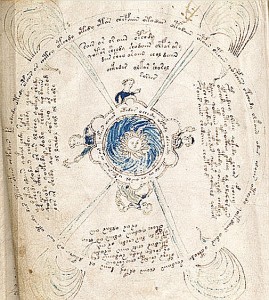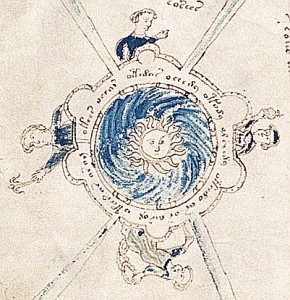Where was the Voynich manuscript produced?
The question posed in my title is one of the most frustrating of all those relating to the Voynich manuscript (VM), and one of the most disputed. Since the VM was rediscovered in 1912 in Italy, many commentators have started from the assumption that it was probably made in Italy. However, others have ventured rather further, suggesting China, Mexico and even outer space!
In the light of all of this speculation, it might simply be best to shelve the question completely, and avoid any discussion of it until we have more solid evidence. In principle, that would be the best option.
However, at the same time, if we had some idea of the provenance of the manuscript, it might help us to understand aspects such as the star names, which could then help us to unlock the script Intel Driver. For this reason it is worth at least  reflecting in a general way on the manuscript’s provenance, if only to delimit the geographical possibilities to some extent and to help us with other areas of analysis.
To my mind, there is enough evidence to suggest an answer to the question which is not so narrow as Italy nor so broad as to encompass China, Mexico or Mars. Let us look at some of this evidence.
1. The illustrations
It is obvious that most of the people represented in the VM illustrations are white Caucasian types (and not oriental, nor Mexican nor Martian). Analysis of the clothing, the famous crossbow in the Sagittarius disk on f73v, and of other elements, has suggested to some a clearly “European” origin 이클립스 jee 다운로드. Analysis of the famous castle in the so-called Rosettes page, with its “swallow-tailed crenellations” has been linked with Genoese building styles. (See a fascinating discussion here by Diane O’Donovan). So surely the provenance of the VM must be Europe, specifically Italy?
Like much else about this blessed manuscript, however, this kind of thinking is far too simplistic. Many elements in the manuscript do not seem to be Italian. You can see from Diane’s discussion referenced above that Genoese influence stretched far beyond the shores of Italy mssql server 다운로드.
I was interviewed by a Russian TV station intrigued by the possibility that the manuscript ‘must be Russian’, and that the Rosettes pages represents a secret map of the Kremlin (which was built apparently with the help of Genoese builders), and the Russian provenance is ‘obvious’ in the (very un-Italian)  onion-domed buildings in the centre circle. So we cannot assume an Italian provenance automatically.
To my mind, a particularly illuminating discussion in this area is that offered by Marco Ponzi, on these pages, concerning f85r2, which you can read here.  Â Â Â Â Â
     
Marco argues convincingly that this page “represents the four seasons and shares the same orientation that we are considering for 69r: Spring at the top, with Summer, Autumn and Winter following counter-clock wise.”
In the light of his argument, in which he points out interesting details in the images and relates them systematically to other images of the four seasons in mediaeval European manuscripts, it seems likely that his interpretation is correct, and a valuable addition to our understanding of the VM. This in turn links the manuscript securely to broad European traditions (as do other elements as well) in a way which must be taken into account in any argument about the manuscript’s provenance ringtone coloring.
Taken together, this and other evidence would seem to indicate a strong European influence at the very least, though – as we will note below – not necessarily an Italian one specifically.
2. Other elements
Other elements seem to support a broad European influence, but not an Italian one. We have the apparent German wording in the manuscript, e.g. on f66r, sometimes read as ‘der Mussdel’, plus some French-looking words (possibly later additions) labelling some of the central Zodiac figures (e.g. here is October). This might of course imply a non-Italian provenance, or simply that the manuscript was later read by non-Italian scholars, and/or travelled around Europe Human Expo font.
3. Script and language
In the area which most interests me concerning the VM, namely the script and language, we see a number of features which suggest some influence from Aramaic script. This has been argued most fully by Derek Vogt on these pages (see the discussion here) and Darren Worley has explored possible Mandaean connections (also with reference to the script as deriving from Aramaic – see his discussion here).
Aramaic itself derives ultimately from Phoenician, the same script which was then adapted by the Greeks, and is still used as the script for many Western languages (including English) in a  form derived in turn from the Romans. So whether or not the VM script derives directly from, say, Syriac, we can say with some confidence that in terms of appearance the VM script seems to have a broadly European/ Near Eastern provenance rather than, say a Chinese or Indian source 장윤정 노래 다운로드.
With regard to the underlying language as encoded in this script, my own research (e.g. here) has suggested that some of the vowels might be either missing, or included with consonants, in the manner of ‘abjad‘ scripts such as Arabic, typical of western Asia.  An example is my reading of the plant name on page f2r as something like ‘K N T / É™/ IR N/ for ‘Centaurun’ or ‘centaury’, in which the first vowel is included or missing, as it would be if the same word were written in Arabic and other abjad scripts. This feature, along with the fact that a number of the proper names I have identified (e.g. ‘Kaur’ for hellebore) seem in my analysis to have Middle Eastern or even Indian influences, suggests to me the possibility that the underlying language, as encoded in this script, might not be a European artefact so much as something deriving from further east.  I also noted a number of other reasons for talking about the language’s ‘Arabic-Persian substratum’.
This does not mean that the language itself is related to Arabic or Persian – after all Spanish (an Indo-European Romance language) Â has an Arabic substratum in terms of words borrowed from Arabic; Urdu has a Persian substratum in several of its features 영 빅토리아 다운로드. Nonetheless, I suggested that it could be a useful clue for decipherment to consider this possible base.
Is this a contradiction? We have suggested that the illustrations and numerous cultural elements seem to point generally to Europe, so how could the language point to an Arabic-Persian element?
In thinking about these areas, we need to bear in mind the very extensive intermixing of Arabic/Persian and European influences over many centuries, in part owing to actual invasions (the Arabs into Spain and large parts of eastern Europe, even Malta and Sicily), but also cultural transmission. Indeed it is widely accepted that much ancient knowledge only exists in modern Europe thanks to its transmission to the Arab world often via Syriac, and later retransmission back to Europe (see this discussion of Greek philosophy for example). This means that is entirely plausible that the VM could have influences from ‘both sides’.
The Voynich manuscript has always looked part-familiar and part-foreign, and maybe this is the explanation atheros 드라이버. In fact it might be that the reason why Western analysts have so far failed to make much headway in deciphering it is that they have been too fixated on the European elements – for example many of them insisting that the underlying language ‘must be Latin’  – and thereby failing to see possibilities a little further afield.
4. So?
It is this kind of reasoning which leads me to suspect that the manuscript was probably created in Europe or in areas to the east, into Asia, heavily influenced by European culture. This could include Turkey (which was still under Greek influence even beyond the taking of Byzantium in 1453, and in my view a good candidate because of its melting pot of Western and Eastern influences), Armenia and other parts of the Caucuses (see my discussion of the superb Armenian scholar Amirdovlat Amasiatsi), even into present day Iraq and Iran (which had communities hugely influenced by Greek and Christian factors) f subtitles of Dragon Ball Resurrection. Areas as far east as India and China had their Christian communities (such as this one), although in my view such a distance does not sit easily with the extensive European influence in the manuscript.
It is only unfortunate that this region does not have a single easy descriptor. I have toyed with Eurasian, Caucasian, European/Near Eastern and others, but none of them seems to encompass the precise region which I feel is most probably the provenance of the manuscript. Suffice it to say that I consider, on the evidence available, that the Voynich manuscript was most probably created between the Atlantic ocean in the west, and the eastern border of Iran, in a place suffused with strong European cultural traditions.
Is that it, you ask? This might seem still rather large and general, but I do feel it is important  not to be too prescriptive on the basis of the evidence we have 매직키드 마수리 다운로드.
Plus at least this allows us to exclude any theory which tells us that it was ‘definitely’ created in east Asia, the Americas, or in outer space!
- Posted in: Voynich ♦ Voynich script and language
272 Comments